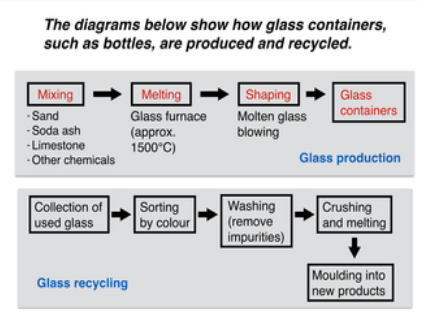TRUNG TÂM NGOẠI NGỮ QUỐC TẾ ĐẠI DƯƠNG
CÁCH VIẾT PROCESS DẠNG BÀI MÔ TẢ OBJECTS TRONG IELTS TASK 1 (ACADEMIC)
Xin chào các em!
Hôm nay chuyên viên giáo dục của công ty du học Đại Dương xin gửi đến các em một vài tips hữu ích cho dạng bài viết quy trình (Process/Diagrams) dạng bài mô tả objects trong IELTS Task 1.
Process được xem là một trong những phần khó với các em lần đầu học writing IELTS. Tuy nhiên, sau khi đoc kỹ các phần hướng dẫn dưới đây và các lời khuyên hữu ích của chuyên viên giáo dục, các em sẽ thấy mình có thể thực hiện loại bài viết này rất dễ dàng!

CÓ BAO NHIÊU DẠNG PROCESS?
Có ba dạng thường gặp nhất của Process là quy trình tự nhiên, quy trình sản xuất (natural process và manufacturing process) và dạng bài mô tả Objects.
Dạng 1: Quy trình sản xuất – Manufacturing process
- Đây là dạng Process về một quá trình sản xuất nhân tạo, một quy trình sản xuất một thứ gì đó, có thể là sản xuất cà phê, sản xuất xi măng, quá trình lọc nước, …Ví dụ:
- The diagrams below show how glass containers, such as bottles, are produced and recycled.
Summarize the information by selecting and reporting the main features and make comparisons where relevant.

Dạng 2: Một quy trình tự nhiên – Natural process
- Ngược lại với quá trình nhân tạo có sự can thiệp của yếu tố bên ngoài, trong quy trình tự nhiên, cá thể tự phát triển và vận động (ví dụ như quy trình tạo ra mưa, sự tiến hoá của con vật…)
Ví dụ:
- The diagram below shows the life cycle of the frog from the egg stage to an adult frog.
Summarize the information by selecting and reporting the main features and make comparisons where relevant.

Dạng 3: Dạng bài mô tả Objects
Ví dụ:
- The diagram below shows the development of cutting tools in the Stone Age. Summarise the information by selecting and reporting the main features and make comparison when relevant.

CÁCH VIẾT DẠNG PROCESS 3
Bố cục của một bài process dạng 3
INTRODUCTION
Lưu ý:
- Viết bằng cách paraphrase lại câu của đề bài
- Có thể sử dụng cấu trúc sau:
-
- The chart/diagram (shows/describes/illustrates) how +clause
- The production of……………..
- The process of producing/ making………………
- How………….is produced/ made.
- How to produce/ make…………
- Ví dụ:
The diagram shows how fresh apple is canned
OVERVIEW
lưu ý:
- Chỉ ra có bao nhiêu giai đoạn trong process ?
- Giới thiệu ngắn gọn bước bắt đầu và kết thúc của process, không kể lể dài dòng để dành việc viết cụ thể các bước cho phần thân bài.
- Nếu đề cho 2 bức tranh cho bài process thì coi như đó là dạng mixed, mỗi body thân bài dành để mô tả cho 1 bức tranh
- Có thể sử dụng cấu trúc sau:
-
- There are ….main stages (steps) in the process/in the process of producing…,beginning with…and ending with…
- The …………………….involves ………………….main steps/ stages beginning with………………and finishing with…………………..
- This flow chart provides an overview of
- Ví dụ:
There are five main steps in the process of producing milk, meanwhile only three stages are required to store it after that.
- In general, the process includes a series of stages like a natural circle (1 vòng tròn tự nhiên)/ a life cycle of…………..(một vòng đời của 1 con vật nào đó), but involves……………..main steps which begins with……………………..and finishes with…………………….
BODY
lưu ý:
- 2 khổ thân bài mô tả chi tiết từng bước của process.
- Xem cả process từ đầu đến giữa viết cho khổ 1, từ giai đoạn giữa đến cuối viết cho khổ 2.
Lưu ý chung cho một bài Process
lưu ý:
- Phải đề cập đến những thay đổi quan trọng trong quy trình
- Nếu thiếu chữ thì không bỏ sót các bước, tuy nhiên nếu bài dài quá có thể gộp các bước để viết
- Khi đọc process, cần chú ý và khoanh tròn các động từ hoặc những key words có thể biến đổi thành các dạng khác nhau của động từ
lấy ví dụ đề cho động từ thì có thể biến đối thành bị động, hoặc danh từ.
- Không nên thể hiện quan điểm cá nhân trong bài Task 1
Cấu trúc nên dùng trong dạng Process
lưu ý:
- S + tobe + V-ed (bị động)
Ví dụ:
-
- At the beginning of the process, clay is dug from the ground.
- Being + V-ed (mệnh đề quan hệ rút gọn với thể bị động)
Ví dụ:
-
- After being washed, the tomatoes are moved to the grilling stage.
- V-ing (khi nói đến thao tác): chú ý đây là câu rút gọn khi 2 chủ ngữ giống nhau
-
- ví dụ: After that, the ground, frozen liquid is dried in a vacuum so that the water evaporates, leaving the coffee granules
- Rút gọn khi 2 câu chung chủ ngữ
ví dụ:
-
- Having mixed the pulp by hand, he uses a rolling pin to flatten the pulp
- Having been poured into a shallow tray with some water, the pulp is then mixed by hand
- Sử dùng liên từ phụ thuộc WHILE
ví dụ:
-
- While bottles are transported to a cleaning factory, other kinds of waste are buried in landfills. (Trong khi những cái chai được vận chuyển đến một nhà máy làm sạch, các loại rác thải khác được chôn ở bãi rác.)
- Rút gọn với WITH
ví dụ:
-
- Olives are smashed into olive paste, with olive stones being taken away. (Những trái ô liu được nghiền thành bột nhão, với những hạt ô liu được lấy đi.)
TỪ VỰNG THƯỜNG DÙNG DẠNG PROCESS
- Từ vựng mô tả quy trình
Các từ vựng được xếp theo thứ tự Bắt đầu > Tiếp theo > Diễn ra cùng lúc > Kết thúc của một process
Bắt đầu process:
lưu ý:
- To begin with,
- First of all,
- In the first step,
- The first step in the process is
- The first stage in the process is
- At the first stage of ….
Ví dụ:
- At the first stage of the paper-recycling process, recycled paper is collected
Các steps tiếp theo:
lưu ý:
- At the following stage, the pulp is poured into a shallow tray and some water is also added. This is followed by a hand-mixing process
- Following that / followed by / At the following stage
Ví dụ:
At the following stage, the pulp is poured into a shallow tray and some water is also added.
This is followed by a hand-mixing process
- The second stage is that…
- In the next/ subsequent step,
- …… followed by…..
- After that, / After
Ví dụ:
Some water is added and the mixture is soaked for an hour. After that, the mixture is beaten for about 45 seconds until a pulp is formed
- After being soaked for an hour, the mixture is beaten….
- Before
Ví dụ:
Before being beaten for about 45 seconds to form a pulp, the mixture is left for an hour
- Subsequent steps
- Subsequently,
Ví dụ:
-
- The mixture is soaked for an hour. Subsequently, the mixture is beaten for about 45 seconds until a pulp is formed
- At the subsequent stage of the process, the mixture is soaked for an hour
lưu ý:
- Subsequently là trạng từ
- The process continue with…
- The next step is
- Then
Ví dụ:
Then, some water is added and the mixture is left for an hour
- Once
Ví dụ:
The mixture is beaten for about 45 seconds and a pulp is formed afterwards. Once it is ready, the pulp is poured into a shallow tra
Các steps diễn ra cùng lúc:
lưu ý:
- While
Ví dụ:
While the mixture of sand and soda is being heated, some other chemicals are added to create various colours
- At the same time,
Ví dụ:
The mixture of sand and soda is heated. At the same time, some other chemicals are added to create various colours
- Simultaneously,
- During
Ví dụ:
During its entire life cycle, salmon have lived in both freshwater and saltwater
- Thereby
Ví dụ:
-
- The rolling pin is used to flatten the pulp, thereby forcing out any excessive water
Kết thúc process:
lưu ý:
- Finally,
- The last/ final process / step is that…
- The process finishes with …
- The process concludes with …
Cách diễn tả sự lặp lại của quy trình
Các bạn nên học các cấu trúc sau:
- The whole process is a cycle which can be divided into 3 main stages
- At this point, a cycle has been completed and a new cycle will begin
BÀI MẪU VỀ PROCESS DẠNG 3
The diagram below shows the development of the cutting tool in the Stone Age.
Summarise the information by selecting and reporting the main features and make comparisons where relevant.

Phân tích
Với đề này, nhiều thí sinh cảm thấy bối rối khi miêu tả Tool A và Tool B vì nó đòi hỏi vốn từ tốt, hơi khác biệt so với trường từ vựng miêu tả xu hướng, dạng bài Process hoặc dạng bài Map trong bài thi IELTS đã học và cần bình tĩnh xử lý các dạng bài này trong khi thi. Dàn bài chi tiết và bài mẫu tham khảo cho đề bài IELTS Writing Task 1 dưới đây sẽ giúp các em chưa thi sẽ có kinh nghiệm trong kỳ thi của mình.
Dàn bài chi tiết
Introduction: Paraphrase lại câu đề bài. Lưu ý nếu trong đề bài sử dụng cấu trúc Danh từ 1 (N1) of Danh từ 2 (N2) thì cách dễ nhất là đổi N1 thành dạng động từ của N2 (Ví dụ: development thành developed). Hoặc thí sinh có thể thay từ development thành evolution.
Overview: Trong đoạn này, thí sinh có thể viết 2 câu về 2 đặc điểm khái quát.
Ví dụ:
Cả 2 Tool đều cùng một độ dài và hình dáng có phần tương tự nhau
Có rất nhiều thay đổi trong hình dạng và kích thước để cải tiến công cụ này.
Lưu ý: Với những dạng này, thí sinh có thể viết 1 câu về đặc điểm chung và 1 câu khái quát về thay đổi ở mặt nào (changes in terms of …)
2 đoạn miêu tả: Có nhiều cách để chia đoạn, nhưng luôn phải có yếu tố so sánh nếu người học đang hướng tới band 6.0. Còn nếu ở band 5.0, thí sinh có thể miêu tả riêng biệt 2 tool. Một cách chia đọan người học có thể tham khảo:
Đoạn 1: Miêu tả Tool A và so sánh 1 chút với Tool B (tương đồng & khác biệt)
Đoạn 2: Miêu tả Tool B và so sánh 1 chút với Tool A (tương đồng & khác biệt)
SAMPLE
The diagram illustrates the evolution of the cutting tool during the period from 1.4 million years ago to 0.8 million years ago in the Stone Age.
It can be seen that a number of upgrades were made in the shape and size of the tool so that it could become a more effective cutting instrument.
1.4 million years ago, the tool was relatively primitive and resembled a natural stone, which suggests that little crafting was done. From the front and side view, Tool A had an oval shape, rough surface and blunt edges, hence presumably the inferior version compared to Tool B.
After 0.6 million years, the tool was upgraded into a spear-shaped instrument with the tip and edges being much sharper. While Tool B was 10 centimeters long – the same length as Tool A, the surface of Tool B was crafted to be smoother and the overall width to be larger. Therefore, these features rendered this version more superior in terms of cutting efficiency.
165 từ
Từ vựng cần chú ý
Upgrade (n): Cải tiến
A more effective cutting instrument: Dụng cụ cắt hiệu quả hơn
Primitive (adj): nguyên thủy
To resemble something (v): Trông giống cái gì
An oval shape, rough surface and blunt edges: Hình ô van, mặt sần sùi và lưỡi cùn
A spear-shaped instrument: dụng cụ có hình ngọn giáo
To render something + adjective: Làm cho cái gì có tính chất gì
Trên đây là các hướng dẫn chi tiết và đơn giản nhất giúp cho các em viết được dang process dễ dàng. Nếu các em có bất cứ thắc mắc gì, hãy liên hệ ngay với Công ty du học Đại Dương để được tư vấn và giúp đỡ nhiệt tình. Công ty du học Đại Dương tự hào là địa chỉ uy tín trong việc giảng dạy và cung cấp các khóa học IELTS đảm bảo đạt mục tiêu đầu ra, thiết kế chương trình học cưc kỳ hiệu quả cho từng cá nhân, giúp sinh viên dễ dàng đạt được mục tiêu điểm IELTS mong muốn trong thời gian ngắn nhất, giúp cho giấc mơ du học của các em hoàn toàn nằm trong tầm tay.
Công ty du học Đại Dương chúc các bạn thật nhiều may mắn, đạt điểm cao trong kỳ thi lấy bằng IELTS nhé!








